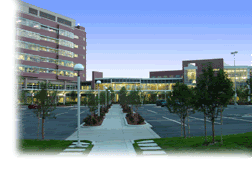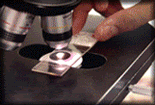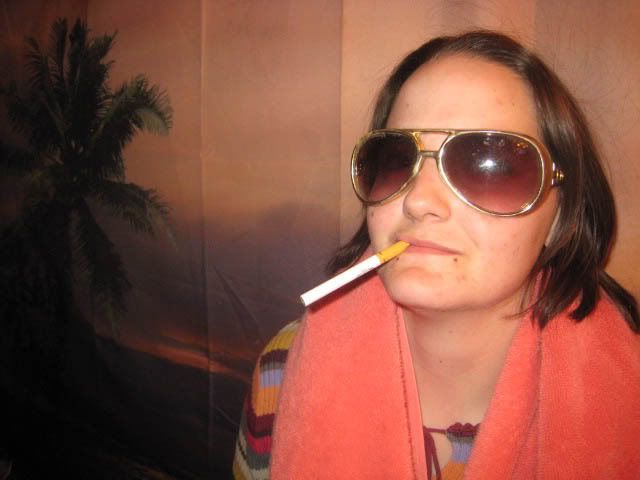
Pathology is the study of pathogens (disease causing things). When most people hear the word they think of dead people; that is a part, but not all of it. I am now on my way to interview a pathologist, and tour a morgue. Dr. Meredith Lann is going to give me a tour of the pathology department and morgue at the University of Colorado Hospital. The hospital is located at the corner of Colorado Blvd. and 8th Ave. in Denver; this is also the location of Cu's School of Medicine, School of Nursing, and School of Pharmacology. It is a teaching hospital, and a location of medical research. (See above picture)
I miscalculated how long the drive was, and ended up getting here early. The building looks like a big cement block with windows from the side that I enter on. The pathology department is located on the second floor of the School of Medicine. When I walk through the doors it looks like a small hospital, with elevators to the right. I get in and go to the second floor, the halls are cluttered with metal cabinets that have pictures of different cells(microscope images) taped to the doors. I get to the pathology housestaff room and walk in. It looks like an office, with gray cubicles set up everywhere; it kind of looks like a big rat maze. A woman with green scrubs on walks in and shows me to Meredith's desk, to sit and wait for her. It's 12:20 in the afternoon.
And as I sit at her cubicle waiting; she isn't supposed to be here until one, I start to look around. At every desk there is a computer and a microscope. It's very quiet, all you can here is a hum from the neon lights, and slight murmuring from other people working at their desks. There is a tray full of slides sitting on her desk; on the slides are chunks of pink-stained tissue samples for her to look at and access. I look at the calendar on the wall of her cubicle: Thursday-cut brain. "Call" is written on various days through the month; this is when she is the one who is in charge of last night and STAT (emergency) cases. On the other wall is a chart with the common weights for human organs at different age and gender groups. Each cubicle has a sign with the name for whose desk it is, and what department they work for i.e.: dermatopathology(skin biopsies) and hematopathology (blood pathogens), showing how diverse the field is.
At one o'clock Dr. Lann comes into the office. She is in her early thirties with shoulder length, light brown hair. She wears slightly rectangular glasses and green scrubs; she still has marks on her face from the mask she was wearing during autopsy. I notice she has a very distended stomach, and I ask, "How far along are you?" She laughs a little and replies, "Seven and a half months. It's funny, I'll be doing some cutting during an autopsy, and he starts kicking." Dr. Lann is in her second year of residency, and is on the autopsy rotation. She has to do fifty cases before she finishes her residency.
She starts me on a tour of the floor. They have an office staff that answers the phones and helps with the paperwork. The office staff have their own office, and they were having a birthday party in there when we walked by; Dr. Lann made sure to get some cake later. The next room down the hall is called the "Gross Room", it has a double meaning: this is where they do gross, or general inspection of the organs, but it is gross because it contains a whole bunch of different body parts. When we walk in the door the smell of formaldehyde is so strong it takes my breath away. There are two stations in the room with vent hoods; A woman with short brown hair is working at one. She has a large mass of dark brown tissue that she is cutting pieces off of. Dr. Lann explains to me that when they need to look closer at a body part or organ, it gets sent here for processing; the woman was cutting slices of a pancreas that had a tumor in it. The slices of tissue will then be sent to the lab down the hall, where they stain the tissue, mount it on a slide, and send it back to the pathologist to look at and diagnose.

Around 2:00 pm we go back into the staff house room and sit at a conference table. This was no ordinary table; it has a microscope at one seat, but also 15 different eyepieces around the table. This means that 15 people can look at the slide at once. She puts in one of the slides from her desk; it is a piece of thyroid gland. The cells are stained a pinkish-purple color; the nuclei of the cells are a dark purple. I ask, "Why would you need to see this on a dead person?" Dr. Lann states, "We don't only deal with tissue from dead people, all pathology residents do clinical pathology rotation, which is biopsies, moles, pap smears, etc. from living people."
The last place she took me was the morgue, it was on the first floor, and not in the basement. The door leading to the morgue area was a heavy wood door with metal plating. It has signs that read: "Biohazard" and "Authorized Personnel Only". When we walked in I got hit with the smell of formaldehyde again, though not as strong; this area is much larger. There is an outside hallway before you get to the autopsy room. In this hallway is a table with gloves and disposable drapes to prep with before an autopsy. In the main room there are two metal tables with drains at one end. There is also a scale for the individual organs, and sinks with disposals for during processing. Dr. Lann emphasizes that when an autopsy is finished the deceased does look normal, if wearing clothes you can't even tell.
When I left at around 3:00 pm, I had a better understanding of the field. It is different than other physician specialties in the fact that it is more flexible. You can take time off when you need to; the dead people aren't going anywhere, but it is also very demanding. The treatment of patients ultimately depends on your diagnosis. And in the case of people that are already deceased, it explains why and maybe how to prevent it in another person. I asked Dr. Lann if there is ever trouble with the patient's family. Dr. Lann said, "Most families want to have an autopsy now, not just to find out why, but because they feel it's a way to help others, and give back to the medical community." Yes, there is gross stuff, but in doing the tour, I found there is much more involved.

No comments:
Post a Comment